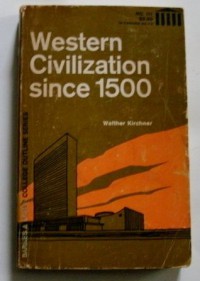Currently reading
Western Civilization since 1500

Covering over 450 years of history in a little over 300 pages seems a daunting task, even more so when it begins in Europe and slowly spreads across the globe. Western Civilization since 1500 by Walther Kirchner is a survey of the rise of European global dominance from the beginnings of “modern times” to the generation after World War II when the periphery powers of the United States and Soviet Union rose to dominance.
Kirchner spends the first 20 pages doing a quick recap of Western Civilization from its Sumerian beginnings to 1500. Then over the course of the next 300 pages, Kirchner divides the approximately 450+ years of history into 20 chapters of specific “eras” whether political and/or cultural developments and happenings. Unlike Kirchner’s previous survey, there was no real “highlight” for the general reader though the significance of some cultural individuals—writers, painters, composers, etc.—that in my own Western Civ and World History classes in high school and college were never mentioned or those that were mentioned that Kirchner didn’t thus showing the difference 30-35 years makes in historical studies. Kirchner obvious adherence to the Marxist theory of history was on full display, but it did not necessarily mean a favorable view of Communist regimes or leaders. As study aid for college students in the mid-1960s there were some interesting miscues (the misdating of the Battle of Yorktown stands out), omissions (the genocidal famine caused by the First Five Year Plan), and downright lies (that the U.S. citizens were sympathetic to the British from the beginning of WWII). Given that this book is over 50 years old there is dated terminology that wouldn’t be used today, not all for politically correct reasons, that would make the reader do a double take if they didn’t know when this book was published.
Though this small volume is meant as a study aid to college students and a quick reference for general readers, to which is essentially succeeds, it is pretty old and should be used by astute history readers to learn how the study of history has changed over time.





 2
2
